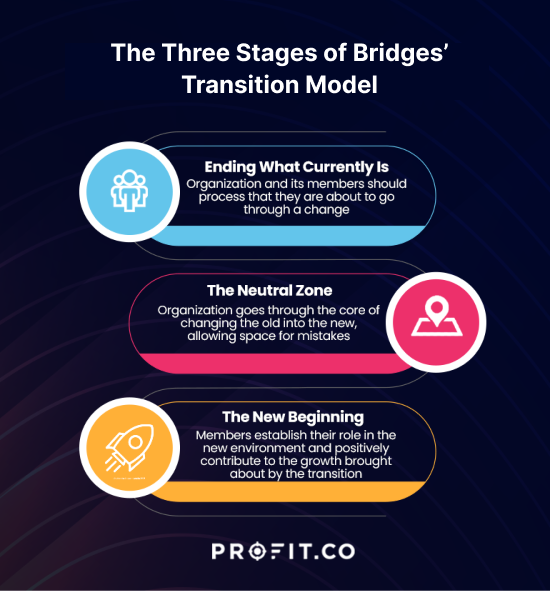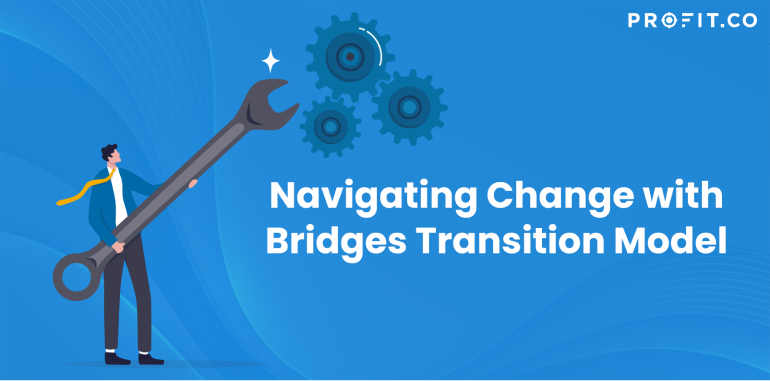The Bridges Transition Model was formulated and established by William Bridges, an American author, speaker, and organizational consultant. Bridges’ background and life work largely revolved around transitions and their role in organizations’ change process. Bridges has an educational background from Harvard, Brown, and Columbia. His actual model first appeared in his book “Managing Transitions” published in 1991.
Let’s dive into Bridges’ Transition Model and how it can effectively guide your team through organizational change.
Three Stages Of Bridges’ Transition Model
While most organizational change management models focus on step-by-step procedures or checklists for implementation, Bridges’ Transition Model aims to help organizations work through the personal and human side of change.
This particular model only has three stages, all of which are involved in how to implement changes and how humans are expected to behave throughout the process of change and transition to the new normal.
The three stages of the Bridges’ Transition Model include
- Ending What Currently Is
- The Neutral Zone
- The New Beginning
Change comes more from managing the journey than from announcing the destination.
Stage 1: Ending What Currently Is
It may sound ironic and paradoxical, but Bridges’ Transition Model starts with “Ending What Currently Is.” In this stage, Bridges recognizes that setting aside time to end the current system when implementing changes is essential.
In this stage, the organization and its members should process that they are about to go through a change. This means they can recognize the things, systems, processes, and traditions they will lose. According to Bridges, this is an important part of the transition because changes can usually mean losing old systems and relationships, locations, and memories.
Having space to recognize and learn how to manage these losses will help them emotionally process the transition. It will also help the organization in general as it lessens the possibility of resistance in the future.
In this stage, the critical thing to do is communicate the change properly and empathize with the people affected by the change. Leaders should also adequately explain what the changes are. Leaders should clarify what the changes entail, their timeline, and how they will ultimately benefit the organization.
Start your Change Management journey today with Profit.co
Stage 2: The Neutral Zone
After ending what it currently is, the organization will enter the so-called “neutral zone.” In this phase, Bridges says members of the organization enter an “in-between time” when the old is gone, but the new isn’t fully operational yet. This can also be called the trial and error phase. People are still learning how to cope with the new changes.
In this stage, the organization will go through the core of changing the old into the new. Members are expected to go through “psychological realignments” and “repatterning.” This means that not only are they learning the basics of the change, but members are also trying to find out how they fit into the change, what role they can play in the new environment, and how they can create new systems to process this.
According to this model, allowing space for mistakes and frustrations in this stage is important because all changes are usually hard to cope with. The organization can move on to the next phase by recognizing these frustrations, allowing them to be communicated efficiently, and facing them head-on
What leaders can do in this stage is always to be open to hearing from members about how they feel, have a mechanism for feedback response, and remind people of the benefits of the transition in the long term. Providing options like resource materials and training will also help
Stage 3: The New Beginning
The last phase is probably the most fulfilling stage of the entire transition process. It is called “The New Beginning phase.” In this part, members can already cope with the transition. You will know that the organization is entering this stage when members learn how to innovate with the changes and are starting to adopt a new, positive attitude towards the transition.
In this stage, members establish their place and role in the new environment and can positively contribute to the growth brought about by the transition. They understand why the change was needed, and they now see the benefits of that change
This stage is critical because while it is the most fulfilling stage, it is also essential to recognize that the organization has reached the transition’s last phase. This should be celebrated and rewarded
To be consistent with the implemented change and retain the positive energy brought about by this stage, leaders are expected to celebrate the organization’s small wins, communicate their progress, and show consistency.

How Does Bridges’ Transition Model Help Organizations?
Bridges’ Transition Model is the model that can and should be used in any organization and any transition, whether big or small. Most of the time, organizations tend to focus on the effectiveness of the implementation and the overarching goal. They tend to forget that organizational change is not only technical but emotional.
Thus, this model is an effective way to understand members while they go through the transition process. An excellent way to use this model is to use it alongside another model when implementing changes or transitions. This way, the organization can get the technical side of change covered and the emotional part. Considering both elements makes for a better and more holistic approach to change.
The OKR methodology can be used to set specific goals for the change and define the key results to indicate progress toward those goals. This goal-setting framework ensures that the organization is focused on achieving specific outcomes related to the change and can measure progress toward those outcomes. The OKR change management program can be effectively leveraged by using both frameworks to provide a structured approach to change management that can minimize disruption and ensure the transition is implemented smoothly and effectively.
FAQs
- What makes Bridges’ Transition Model different from other change management models?
While most organizational change models focus on step-by-step procedures or checklists for implementation, Bridges’ Transition Model aims to help organizations work through the personal and human side of change.
- What are the three stages of Bridges’ Transitional Model?
The three stages of the Bridges’ Transition Model include: Ending What Currently Is, The Neutral Zone, and The New Beginning.
- How does Bridges’ Transition Model help organizations?
The Bridges’ Transition Model helps organizations consider employees’ emotions while experiencing change, which assists in the success of policy change.
Conclusion
Organizational change is essential for every organization to innovate and thrive. Utilizing Bridges’ Transition Model will allow your team to give adequate space and time for changes. Innovation is not an overnight process, and Bridges’ Transition Model accounts for the hurdles and challenges that arise during transformation. The model combines emotional and technical aspects of change, ensuring your team has a smooth and successful journey.

